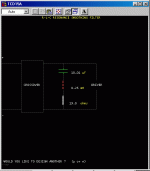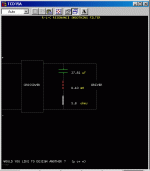Below is the response curve for the Audax AP210ZO 8" speaker. We are going for a crossover to an Audax TM25F1 tweeter.
I think the best way to go is to eliminate the peak at 3,000 Hz and to consider the natural curve a 6 dB/octave crossover.
For impedance purposes, the horizontal lines are 5 ohms apart, so the impedance is 19 ohms at 3,000 Hz. I used 19 ohms as the "rated impedance of the speaker" since the speaker's impedance is 19 ohms at 3,000 Hz.
Bear in mind that the individual doing this project does not have the setup to do a response curve, so we have to get it right the first time.
I think the best way to go is to eliminate the peak at 3,000 Hz and to consider the natural curve a 6 dB/octave crossover.
For impedance purposes, the horizontal lines are 5 ohms apart, so the impedance is 19 ohms at 3,000 Hz. I used 19 ohms as the "rated impedance of the speaker" since the speaker's impedance is 19 ohms at 3,000 Hz.
Bear in mind that the individual doing this project does not have the setup to do a response curve, so we have to get it right the first time.
Attachments
Here is the circuit a simple DOS program gave for taking out the notch at 3,000 Hz. I gave the rated impedance as 19 ohms, since that is what it is at 3,000 Hz. When I gave the actual rated impedance of the speaker, 8 ohms, the values were the same except R=8 ohms instead of 19 ohms.
Attachments
The same program gave the following values after asking for the DC resistance, Qes, Qms, and of course, what resonant frequency of the notch filter. The results are below.
So, should I use the notch filter and consider the AP210ZO as having as natural 6 dB cutoff?
If so, which set of values should I use?
I am perfectly willing to use impedance compensation if that would improve matters, though I suppose it might throw values off in the second chart.
Anyone with any thoughts on this, or who has a more sophisticated program, just jump right in.
So, should I use the notch filter and consider the AP210ZO as having as natural 6 dB cutoff?
If so, which set of values should I use?
I am perfectly willing to use impedance compensation if that would improve matters, though I suppose it might throw values off in the second chart.
Anyone with any thoughts on this, or who has a more sophisticated program, just jump right in.
Attachments
- Status
- Not open for further replies.


